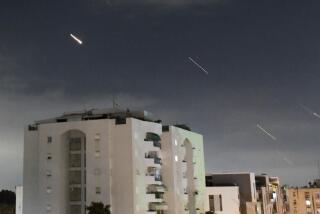A Safe Journey Home for Space Shuttle, NASA
The space shuttle Discovery roared out of a gray sky Monday and safely landed at Kennedy Space Center, concluding a 13-day mission that clears the way for resuming construction of the International Space Station.
NASA officials said the successful mission showed that the shuttle program was “back on track” after setbacks that began with the loss of the shuttle Columbia in 2003 and continued with last year’s problem-plagued shuttle mission.
“We had a great flight,” said NASA Administrator Michael D. Griffin.
NASA is now preparing to step up shuttle flights to an average of four a year in a race to finish work on the space station by the time the aging and glitch-prone shuttle fleet is retired in 2010.
“We don’t have any slack, so we can’t afford to mess up,” said Griffin, addressing reporters at Kennedy Space Center. “We know what the job is before us, and we have to do it.”
The next scheduled shuttle launch could come as early as Aug. 28. The shuttle Atlantis will carry a space station truss and a solar array. By this fall, Griffin will decide whether to attempt a repair mission to the deteriorating Hubble Space Telescope.
The return of Discovery was heralded by a pair of sonic booms that echoed over the central Florida coast just before 6:15 a.m. PDT. Several hundred observers in grandstands cheered and clapped, perhaps as much out of relief as celebration. All shuttle flights are risky, but the loss of Columbia in 2003 underscored the hazards associated with returning from space, which exposes the shuttle and its fragile heat shield to temperatures above 2,000 degrees.
NASA spent three years and more than $1 billion on improving the shuttle and its giant external fuel tank. The tank was the source of a piece of hard insulating foam that fell off and fatally damaged Columbia. Besides removing more than 30 pounds of foam from the tank, NASA replaced the tires and wheels with stronger models, and installed tighter seals around the landing gear doors.
The upgrades seemed to have worked. After a walk-around inspection of the craft after the landing, Discovery commander Steve Lindsey said he had “never seen a vehicle that looked as clean as this one did” after a flight.
But William H. Gerstenmaier, associate administrator for space operations, cautioned that much data collected by the shuttle’s cameras and sensors still needed to be analyzed over the coming weeks before the shuttle redesigns could be declared a success.
“It’s too early to say luck or performance,” Gerstenmaier said. But he added that the early evidence showed that “the vehicle performed awesome.”
The landing was the final act in a mission that included three spacewalks by astronauts Michael E. Fossum and Piers J. Sellers. They made repairs on a transporter outside the space station that will be used by future astronauts in station construction. They also tested a shuttle repair material called “the goo” on predamaged reinforced carbon protective panels, which cover the front of the wings and nose cone of the craft.
Discovery underwent seven different examinations during the mission to make sure it had not been damaged during its eight-minute ascent into space.
Discovery began its reentry when Lindsey fired the shuttle’s engines for three minutes as it glided upside-down 211 miles over the Indian Ocean. The maneuver flipped the orbiter into an upright position for its entry into the upper atmosphere.
Lindsey later described watching the moon through the plasma, a gaseous soup created by the interaction of the shuttle’s engines and the superheated atmosphere.
“It was just wild,” Lindsey said.
The shuttle’s onboard computer controlled a series of sweeping turns in the upper atmosphere to slow the spacecraft enough for landing. At the last moment, suddenly worsening weather required Lindsey and pilot Mark E. Kelly to take the controls and change direction to land from the north, instead of the south.
There were concerns over a leak in one of three units that powered braking and other landing operations. But the landing was unaffected, officials said.
The landing was a homecoming for the shuttle, which had not landed at Kennedy Space Center in nearly four years. Last year’s first return-to-flight mission concluded at Edwards Air Force Base in California because the weather prohibited a Florida landing.
Lindsey said he didn’t see the successful mission as a concluding chapter to a troubled time at NASA but rather as the beginning of another phase in the space program. “I don’t think we ever want to put Columbia behind us,” he said.
NASA managers said the space station’s assembly work scheduled for upcoming flights is some of the most complex work in space that astronauts have ever attempted. Besides the station truss and the solar array, Japanese and European science modules are scheduled for installation.
NASA committed to building the space station in 1980s when the agency was searching for a new long-term goal after the successes of the Apollo moon missions. The agency came up with the idea of a big space station that could serve as a laboratory for scientists from around the world.
In practice, many at NASA have lost interest in the project, particularly after the president announced his bracing new space vision in 2004, which calls for a return to the moon and an eventual journey to Mars.
Critics also note the station’s cost, originally forecast at $8 billion. It has ballooned to several times that figure.
But because the shuttle is the only space vehicle that can carry large construction materials into orbit, and because the Europeans and Japanese remain enthusiastic supporters of the station concept, NASA is obligated to finish construction.
The shuttle fleet has flown 16 construction missions so far, with another 15 scheduled between now and the station’s projected completion.
*
(BEGIN TEXT OF INFOBOX)
With the shuttle’s fleet retirement date looming, NASA plans to launch at least 15 flights by September 2010 to finish construction on the International Space Station.
A tight schedule
[Date: Shuttle]
2006
Aug. 28: Atlantis
Dec. 14: Discovery
*
2007
Late February: Atlantis
Mid-June: Endeavour
Early August: Atlantis
Late September: Discovery
Late November: Endeavour
*
At least eight more construction flights are planned between December 2007 and September 2010.
*
Source: Rob Navias, NASA spokesman Graphics reporting by Brady MacDonald
More to Read
Start your day right
Sign up for Essential California for news, features and recommendations from the L.A. Times and beyond in your inbox six days a week.
You may occasionally receive promotional content from the Los Angeles Times.






